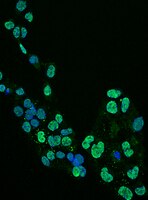Olig1 function is required for oligodendrocyte differentiation in the mouse brain.
Dai, J; Bercury, KK; Ahrendsen, JT; Macklin, WB
The Journal of neuroscience : the official journal of the Society for Neuroscience
35
4386-402
2015
Abstract anzeigen
Oligodendrocyte differentiation and myelination are tightly regulated processes orchestrated by a complex transcriptional network. Two bHLH transcription factors in this network, Olig1 and Olig2, are expressed exclusively by oligodendrocytes after late embryonic development. Although the role of Olig2 in the lineage is well established, the role of Olig1 is still unclear. The current studies analyzed the function of Olig1 in oligodendrocyte differentiation and developmental myelination in brain. Both oligodendrocyte progenitor cell commitment and oligodendrocyte differentiation were impaired in the corpus callosum of Olig1-null mice, resulting in hypomyelination throughout adulthood in the brain. As seen in previous studies with this mouse line, although there was an early myelination deficit in the spinal cord, essentially full recovery with normal spinal cord myelination was seen. Intriguingly, this regional difference may be partially attributed to compensatory upregulation of Olig2 protein expression in the spinal cord after Olig1 deletion, which is not seen in brain. The current study demonstrates a unique role for Olig1 in promoting oligodendrocyte progenitor cell commitment, differentiation, and subsequent myelination primarily in brain, but not spinal cord. | 25762682
 |










